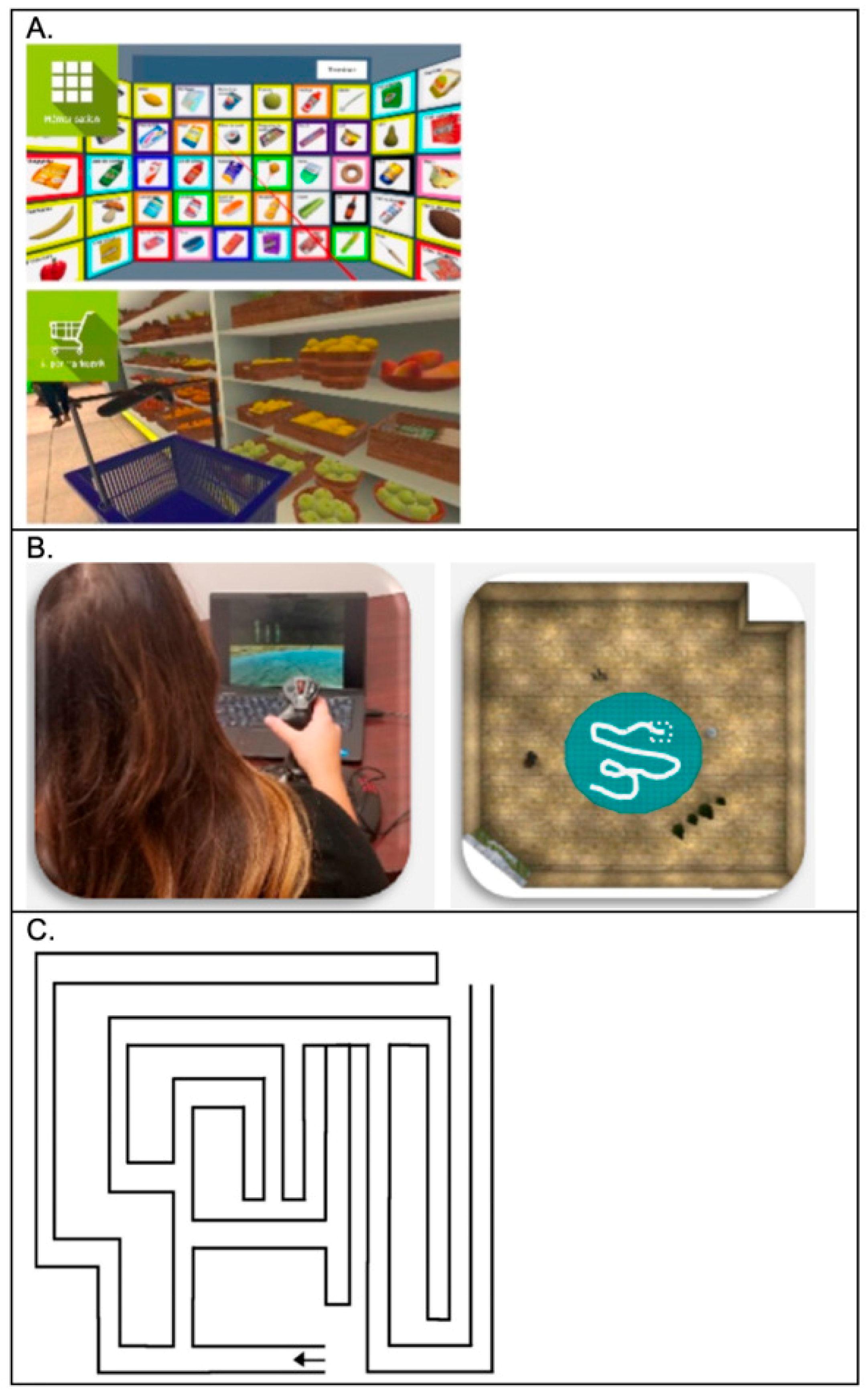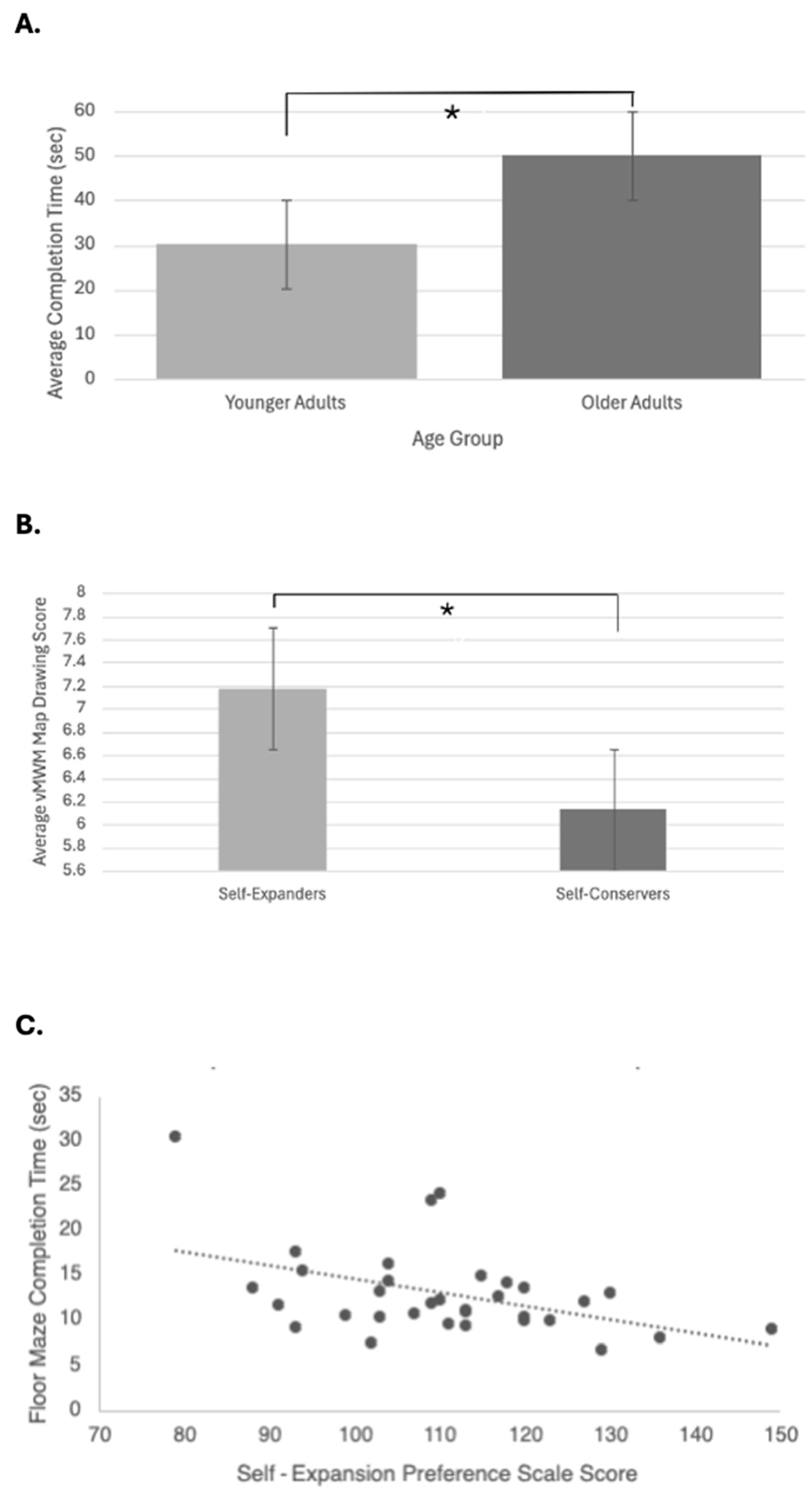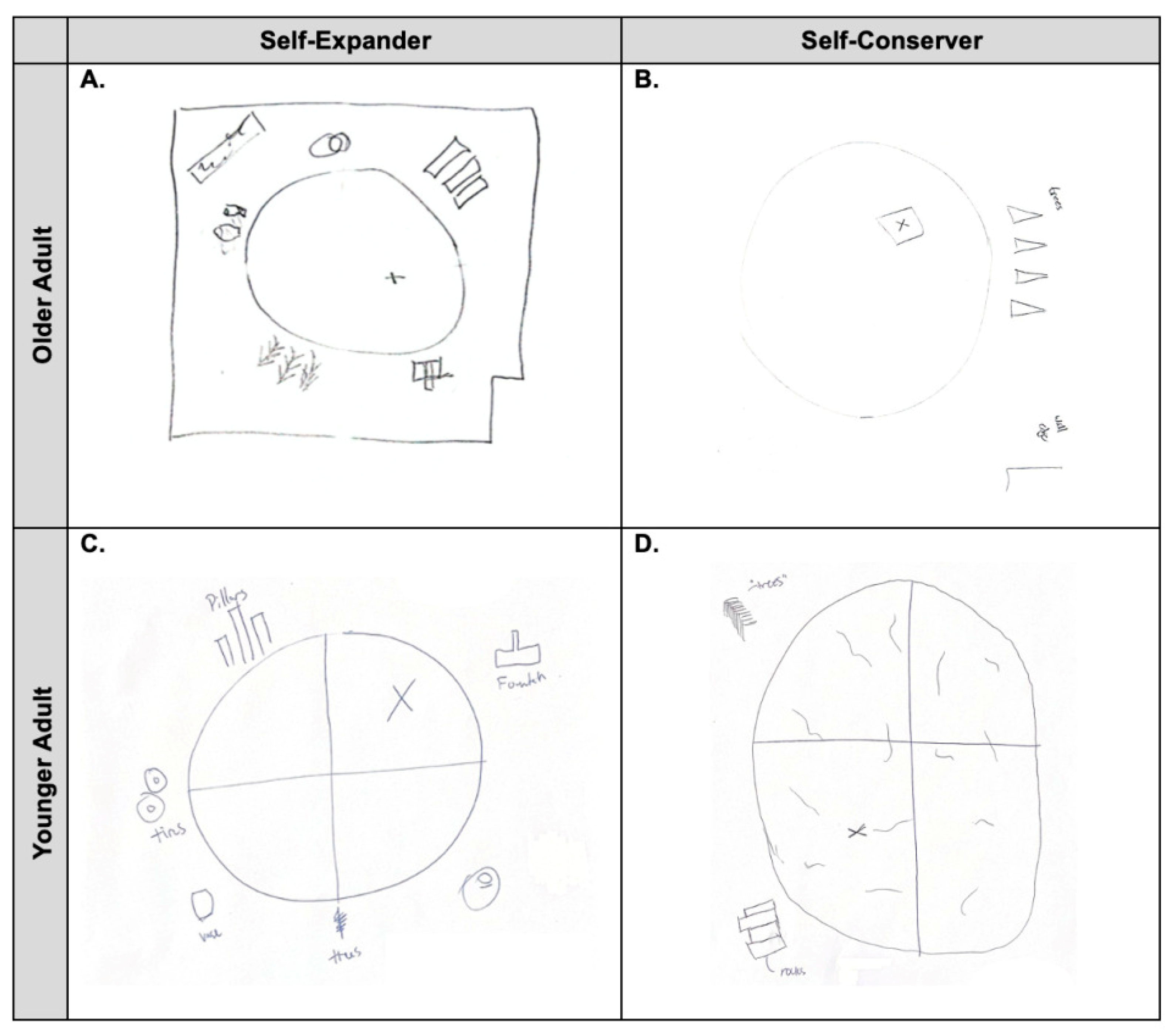Age and Self-Expansion Behaviors Correlate with Spatial Navigation in Healthy Adults
Abstract
1. Introduction
2. Materials and Methods
2.1. Participants
2.2. Self-Reported Questionnaires
2.2.1. Self-Expansion Preference Scale (SEPS)
2.2.2. Wayfinding Questionnaire (WQ)
2.3. Immersive Virtual Reality
The Supermarket Task (Figure 1A)

2.4. Non-Immersive Virtual Reality (NI-VR)
Virtual Morris Water Maze (vMWM) (Figure 1B)
2.5. Overground SN
Floor Maze Task (FMT) (Figure 1C)
2.6. Statistical Methods
3. Results
3.1. OAs Demonstrated Worse Efficiency as Compared to YAs in the vMWM
3.2. Self-Expansion Was Associated with Better Environment Recall
3.3. Self-Expansion Correlated with Better SN Performance Across Paradigms in YAs
4. Discussion
5. Limitations
6. Conclusions
Supplementary Materials
Author Contributions
Funding
Institutional Review Board Statement
Informed Consent Statement
Data Availability Statement
Acknowledgments
Conflicts of Interest
References
- Silva, D.; Feng, T.; Foster, D.J. Trajectory events across hippocampal place cells require previous experience. Nat. Neurosci. 2015, 18, 1772–1779. [Google Scholar] [CrossRef]
- Muffato, V.; Meneghetti, C.; De Beni, R. The role of visuo-spatial abilities in environment learning from maps and navigation over the adult lifespan. Br. J. Psychol. 2020, 111, 70–91. [Google Scholar] [CrossRef]
- Vieites, V.; Pruden, S.M.; Reeb-Sutherland, B.C. Childhood wayfinding experience explains sex and individual differences in adult wayfinding strategy and anxiety. Cogn. Res. Princ. Implic. 2020, 5, 12. [Google Scholar] [CrossRef]
- Maybrier, H.; Palanca, B.J.A.; Head, D. Associations of environmental and lifestyle factors with spatial navigation in younger and older adults. J. Int. Neuropsychol. Soc. 2023, 29, 377–387. [Google Scholar] [CrossRef]
- van der Ham, I.J.M.; Claessen, M.H.G.; Evers, A.W.M.; van der Kuil, M.N.A. Large-scale assessment of human navigation ability across the lifespan. Sci. Rep. 2020, 10, 3299. [Google Scholar] [CrossRef]
- Placido, J.; de Almeida, C.A.B.; Ferreira, J.V.; de Oliveira Silva, F.; Monteiro-Junior, R.S.; Tangen, G.G.; Laks, J.; Deslandes, A.C. Spatial navigation in older adults with mild cognitive impairment and dementia: A systematic review and meta-analysis. Exp. Gerontol. 2022, 165, 111852. [Google Scholar] [CrossRef] [PubMed]
- Muffato, V.; Borella, E.; Pazzaglia, F.; Meneghetti, C. Orientation Experiences and Navigation Aid Use: A Self-Report Lifespan Study on the Role of Age and Visuospatial Factors. Int. J. Environ. Res. Public Health 2022, 19, 1225. [Google Scholar] [CrossRef]
- Daugherty, A.M.; Yuan, P.; Dahle, C.L.; Bender, A.R.; Yang, Y.; Raz, N. Path Complexity in Virtual Water Maze Navigation: Differential Associations with Age, Sex, and Regional Brain Volume. Cereb. Cortex 2015, 25, 3122–3131. [Google Scholar] [CrossRef] [PubMed]
- Walkowiak, S.; Foulsham, T.; Eardley, A.F. Individual differences and personality correlates of navigational performance in the virtual route learning task. Comput. Hum. Behav. 2015, 45, 402–410. [Google Scholar] [CrossRef]
- Aron, A.; Norman, C.; Aron, E. The Self-Expansion Model and Motivation. In Representative Research in Social Psychology; University of North Carolina: Chapel Hill, NC, USA, 1998; pp. 1–13. [Google Scholar]
- Hughes, E.K.; Slotter, E.B.; Lewandowski, G.W. Expanding Who I Am: Validating the Self-Expansion Preference Scale. J. Pers. Assess. 2020, 102, 792–803. [Google Scholar] [CrossRef]
- Aron, A.; Aron, E. Love and the Expansion of Self: Understanding Attraction and Satisfaction; Hemisphere Publishing Corp/Harper & Row Publishers: Washington, DC, USA, 1986. [Google Scholar]
- Diersch, N.; Wolbers, T. The potential of virtual reality for spatial navigation research across the adult lifespan. J. Exp. Biol. 2019, 222 (Suppl. S1), jeb187252. [Google Scholar] [CrossRef] [PubMed]
- Bauer, A.C.M.; Andringa, G. The Potential of Immersive Virtual Reality for Cognitive Training in Elderly. Gerontology 2020, 66, 614–623. [Google Scholar] [CrossRef]
- Thorp, S.O.; Rimol, L.M.; Lervik, S.; Evensmoen, H.R.; Grassini, S. Comparative analysis of spatial ability in immersive and non-immersive virtual reality: The role of sense of presence, simulation sickness and cognitive load. Front. Virtual Real. 2024, 5, 1343872. [Google Scholar] [CrossRef]
- Fusco, A.; Tieri, G. Challenges and Perspectives for Clinical Applications of Immersive and Non-Immersive Virtual Reality. J. Clin. Med. 2022, 11, 4540. [Google Scholar] [CrossRef]
- Bevilacqua, R.; Maranesi, E.; Riccardi, G.R.; Di Donna, V.; Pelliccioni, P.; Luzi, R.; Lattanzio, F.; Pelliccioni, G. Non-Immersive Virtual Reality for Rehabilitation of the Older People: A Systematic Review into Efficacy and Effectiveness. J. Clin. Med. 2019, 8, 1882. [Google Scholar] [CrossRef]
- Feng, Y.; Duives, D.C.; Hoogendoorn, S.P. Wayfinding behaviour in a multi-level building: A comparative study of HMD VR and Desktop VR. Adv. Eng. Inform. 2022, 51, 101475. [Google Scholar] [CrossRef]
- Puthusseryppady, V.; Cossio, D.; Yu, S.; Rezwana, F.; Hegarty, M.; Jacobs, E.G.; Chrastil, E.R. Less spatial exploration is associated with poorer spatial memory in midlife adults. Front. Aging Neurosci. 2024, 16, 1382801. [Google Scholar] [CrossRef]
- de Rooij, N.K.; Claessen, M.H.G.; van der Ham, I.J.M.; Post, M.W.M.; Visser-Meily, J.M.A. The Wayfinding Questionnaire: A clinically useful self-report instrument to identify navigation complaints in stroke patients. Neuropsychol. Rehabil. 2019, 29, 1042–1061. [Google Scholar] [CrossRef]
- Moffat, S.D.; Resnick, S.M. Effects of age on virtual environment place navigation and allocentric cognitive mapping. Behav. Neurosci. 2002, 116, 851–859. [Google Scholar] [CrossRef]
- Daugherty, A.M.; Bender, A.R.; Yuan, P.; Raz, N. Changes in Search Path Complexity and Length During Learning of a Virtual Water Maze: Age Differences and Differential Associations with Hippocampal Subfield Volumes. Cereb. Cortex 2016, 26, 2391–2401. [Google Scholar] [CrossRef] [PubMed]
- Daugherty, A.M.; Raz, N. A virtual water maze revisited: Two-year changes in navigation performance and their neural correlates in healthy adults. NeuroImage 2017, 146, 492–506. [Google Scholar] [CrossRef]
- Gazova, I.; Laczó, J.; Rubinova, E.; Mokrisova, I.; Hyncicova, E.; Andel, R.; Vyhnalek, M.; Sheardova, K.; Coulson, E.J.; Hort, J. Spatial navigation in young versus older adults. Front. Aging Neurosci. 2013, 5, 94. [Google Scholar] [CrossRef] [PubMed]
- Moffat, S.D.; Zonderman, A.B.; Resnick, S.M. Age differences in spatial memory in a virtual environment navigation task. Neurobiol. Aging 2001, 22, 787–796. [Google Scholar] [CrossRef] [PubMed]
- Hill, P.F.; Bermudez, S.; McAvan, A.S.; Garren, J.D.; Grilli, M.D.; Barnes, C.A.; Ekstrom, A.D. Age differences in spatial memory are mitigated during naturalistic navigation. Aging Neuropsychol. Cogn. 2024, 31, 1106–1130. [Google Scholar] [CrossRef] [PubMed]
- Schöberl, F.; Zwergal, A.; Brandt, T. Testing Navigation in Real Space: Contributions the Physiology and Pathology of Human Navigation Control. Front. Neural Circuits 2020, 14, 6. [Google Scholar] [CrossRef]
- Xu, T.B.; Govani, V.N.; Kalantari, S. Age differences in pedestrian navigational skills and performance: A systemic review and meta-analysis. Ageing Res. Rev. 2025, 104, 102591. [Google Scholar] [CrossRef]
- Zanco, M.; Plácido, J.; Marinho, V.; Ferreira, J.V.; de Oliveira, F.; Monteiro-Junior, R.; Barca, M.; Engedal, K.; Laks, J.; Deslandes, A. Spatial Navigation in the Elderly with Alzheimer’s Disease: A Cross-Sectional Study. J. Alzheimers Dis. JAD 2018, 66, 1683–1694. [Google Scholar] [CrossRef]
- Chapman, B.P.; Benedict, R.H.; Lin, F.; Roy, S.; Federoff, H.J.; Mapstone, M. Personality and Performance in Specific Neurocognitive Domains Among Older Persons. Am. J. Geriatr. Psychiatry Off J. Am. Assoc. Geriatr. Psychiatry 2017, 25, 900–908. [Google Scholar] [CrossRef]
- Graham, E.K.; Lachman, M.E. Personality Stability Is Associated with Better Cognitive Performance in Adulthood: Are the Stable More Able? J. Gerontol. Ser. B 2012, 67, 545–554. [Google Scholar] [CrossRef]
- Liu, S.; Tang, Y.; Peng, M.; Lewandowski, G.W., Jr. The effect of self-expansion on creativity: Examining the role of novelty experiences. Psychol. Aesthet. Creat. Arts 2024. [Google Scholar] [CrossRef]
- Taillade, M.; Sauzéon, H.; Dejos, M.; Arvind Pala, P.; Larrue, F.; Wallet, G.; Gross, C.; N’Kaoua, B. Executive and memory correlates of age-related differences in wayfinding performances using a virtual reality application. Aging Neuropsychol. Cogn. 2013, 20, 298–319. [Google Scholar] [CrossRef] [PubMed]
- Xu, X.; Tupy, S.; Sharp, J.L.; Miller, A.L.; Correll, D.; Nigg, C.R. Self-expansion is positively associated with Fitbit-measured daily steps across 4-weeks. Sci. Rep. 2022, 12, 20547. [Google Scholar] [CrossRef] [PubMed]


| Tests | Older Adults (OA) | Younger Adults (YA) |
|---|---|---|
| Self-Expansion Preference Scale | X | X |
| Wayfinding Questionnaire | X | |
| IVR Supermarket Task | X | |
| Virtual Morris Water Maze | X | X |
| Floor Maze | X |
| Older Adult (OA) (n = 74) | Younger Adults (YA) (n = 33) | |
|---|---|---|
| Age (years), Mean ± SD | 69.5 ± 8.0 | 25.0 ± 1.6 |
| Sex, n (%) | ||
| Female | 52 (70.3%) | 19 (57.6%) |
| Male | 22 (29.7%) | 14 (42.4%) |
| Race, n (%) | ||
| Asian | 1 (1.4%) | 2 (6.1%) |
| Black | 13 (17.6%) | 0 (0.0%) |
| Middle Eastern | 0 (0.0%) | 3 (9.1%) |
| White | 60 (81.1%) | 27 (81.8%) |
| Other | 0 (0.0%) | 1 (3.0%) |
| Forced Choice on Self-Expansion Preference Scale, n (%) | ||
| Self-Expander | 50 (67.6%) | 20 (60.6%) |
| Self-Conserver | 11 (14.9%) | 13 (39.4%) |
| Not Completed | 13 (17.6%) | 0 (0.0%) |
| Prior Computer Experience, n (%) | ||
| Almost everyday | 53 (71.6%) | 33 (100.0%) |
| A few times per week | 14 (18.9%) | 0 (0.0%) |
| A few times per month | 3 (4.1%) | 0 (0.0%) |
| Several times per year | 3 (4.1%) | 0 (0.0%) |
| A few times per year | 0 (0.0%) | 0 (0.0%) |
| A few times in my life | 1 (1.4%) | 0 (0.0%) |
| I have never used a computer before | 0 (0.0%) | 0 (0.0%) |
| Prior Computer Game Experience, n (%) | ||
| Almost everyday | 6 (8.1%) | 1 (3.0%) |
| A few times per week | 2 (2.7%) | 7 (21.2%) |
| A few times per month | 5 (67.6%) | 4 (12.1%) |
| Several times per year | 0 (0.0%) | 5 (15.2%) |
| A few times per year | 10 (13.5%) | 3 (9.1%) |
| A few times in my life | 39 (52.7%) | 13 (39.4%) |
| I have never played computer games | 12 (16.2%) | 0 (0.0%) |
| Prior 3D Environment Computer Game Experience, n (%) | ||
| Almost everyday | 0 (0.0%) | 1 (3.0%) |
| A few times per week | 0 (0.0%) | 1 (3.0%) |
| A few times per month | 0 (0.0%) | 1 (3.0%) |
| Several times per year | 1 (1.4%) | 3 (9.1%) |
| A few times per year | 5 (6.8%) | 3 (9.1%) |
| A few times in my life | 39 (52.7%) | 17 (51.5%) |
| I have never played these games | 29 (39.2%) | 7 (21.2%) |
Disclaimer/Publisher’s Note: The statements, opinions and data contained in all publications are solely those of the individual author(s) and contributor(s) and not of MDPI and/or the editor(s). MDPI and/or the editor(s) disclaim responsibility for any injury to people or property resulting from any ideas, methods, instructions or products referred to in the content. |
© 2025 by the authors. Licensee MDPI, Basel, Switzerland. This article is an open access article distributed under the terms and conditions of the Creative Commons Attribution (CC BY) license (https://creativecommons.org/licenses/by/4.0/).
Share and Cite
Ansara, M.; Duggan, M.; Schafer, A.; Villalobos, K.; Chargo, A.N.; Daugherty, A.M.; Takla, T.N.; Fritz, N.E. Age and Self-Expansion Behaviors Correlate with Spatial Navigation in Healthy Adults. Brain Sci. 2025, 15, 1002. https://doi.org/10.3390/brainsci15091002
Ansara M, Duggan M, Schafer A, Villalobos K, Chargo AN, Daugherty AM, Takla TN, Fritz NE. Age and Self-Expansion Behaviors Correlate with Spatial Navigation in Healthy Adults. Brain Sciences. 2025; 15(9):1002. https://doi.org/10.3390/brainsci15091002
Chicago/Turabian StyleAnsara, Melissa, MaKayla Duggan, Alana Schafer, Karina Villalobos, Alexis N. Chargo, Ana M. Daugherty, Taylor N. Takla, and Nora E. Fritz. 2025. "Age and Self-Expansion Behaviors Correlate with Spatial Navigation in Healthy Adults" Brain Sciences 15, no. 9: 1002. https://doi.org/10.3390/brainsci15091002
APA StyleAnsara, M., Duggan, M., Schafer, A., Villalobos, K., Chargo, A. N., Daugherty, A. M., Takla, T. N., & Fritz, N. E. (2025). Age and Self-Expansion Behaviors Correlate with Spatial Navigation in Healthy Adults. Brain Sciences, 15(9), 1002. https://doi.org/10.3390/brainsci15091002










